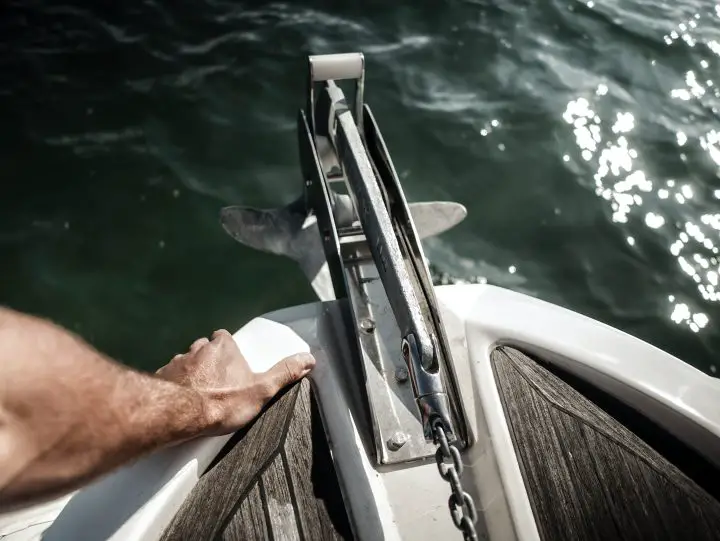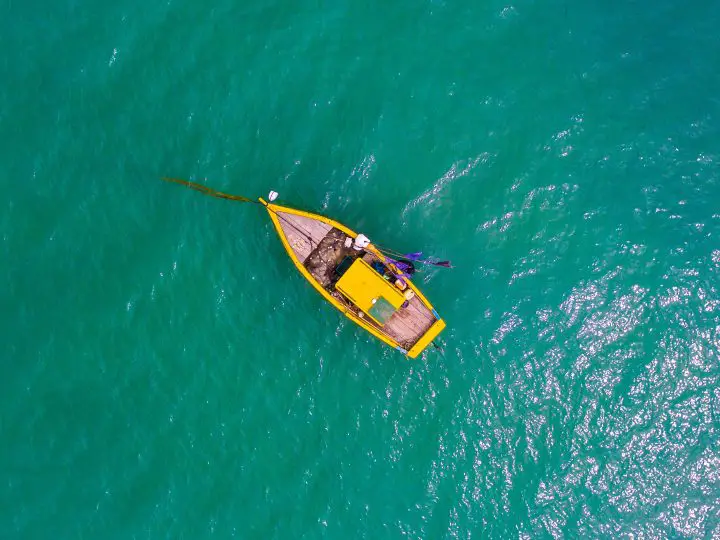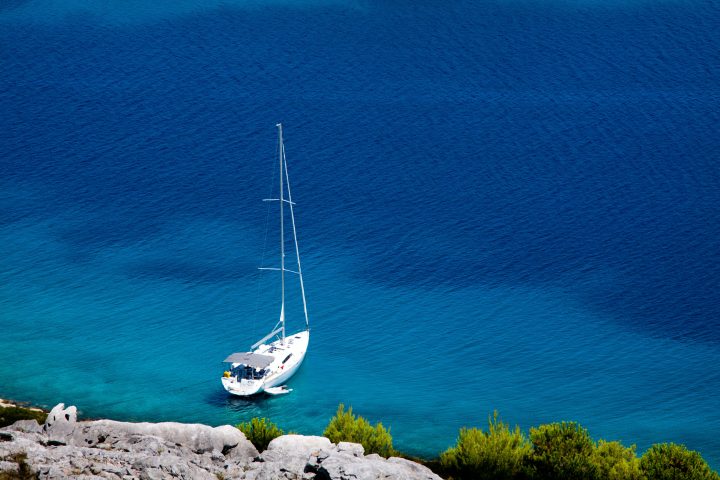To my surprise, this question comes up a lot on the internet. It seems that there’s a lot of confusion surrounding the topic of anchoring, along with some tips floating around that are downright dangerous.
So, can you anchor a boat at the stern? You can, but it’s a risky move. If you don’t understand the risks, don’t do it.
Let’s look at some anchoring questions and dive into some tips on how to anchor a boat safely.
Table of Contents
- What Could Happen If You Anchor a Boat From the Stern?
- Can You Anchor a Boat at the Stern?
- Risks and Dangers of Anchoring a Boat from the Stern
- When Is it Okay to Use a Stern Anchor?
- Tips for Anchoring the Boat Safely
- Anchoring FAQs

What Could Happen If You Anchor a Boat From the Stern?
Anchoring a boat from the stern, rather than the bow, can lead to several potential problems, some of which could be quite serious depending on the conditions:
- Reduced Stability: The design of most boats means they are intended to face into the wind and waves. When a boat is anchored from the stern, it is more likely to swing excessively or be pushed sideways against the oncoming waves. This can cause the boat to rock more violently, making it less stable and potentially uncomfortable or dangerous for those on board.
- Risk of Flooding: The stern of many boats is lower than the bow and often closer to the waterline, especially in powerboats. Anchoring from the stern can increase the risk of water washing over the stern and into the boat, leading to possible flooding, especially in rough conditions.
- Engine and Propeller Damage: For boats with outboard or stern-drive systems, anchoring from the stern can increase the risk of damage to the engine and propeller, especially if the boat swings or drifts into shallow areas. The engine and propeller are more exposed and vulnerable when positioned downwind or downcurrent of the anchor.
- Compromised Handling and Safety: Boats are designed to naturally drift or lie in the water with the bow facing into the wind or current due to their hull shape. Stern anchoring can compromise the boat’s natural handling characteristics, making it more difficult to maintain control in windy conditions or strong currents.
- Increased Load on Anchor Gear: Anchoring from the stern can also put additional strain on the anchor gear. The windage (the area exposed to the wind) of the boat is often greater towards the stern, which can increase the load on the anchor and the risk of it dragging.
- Difficulty in Emergency Maneuvers: In case of anchor drag or a need to quickly move the boat, having the anchor deployed from the stern can complicate maneuvers. It might be harder to retrieve the anchor quickly and safely, and positioning the boat to deal with emergencies or changing conditions could be more challenging.
It’s important to note that while anchoring from the stern is generally not recommended, there are specific situations where it might be done safely, such as in calm conditions or when using a stern anchor in conjunction with a bow anchor to stabilize the boat. However, these are exceptions rather than the rule, and understanding the limitations and risks is crucial.
Can You Anchor a Boat at the Stern?
Let’s start with this topic because it seems to me to be, potentially, the most dangerous idea floating around. Just because you can do a thing does not make it a good idea. And just because something worked out well once for one guy does not make it good seamanship.
The problem with blanket advice with anchoring is that folks tend to associate it with all types of boats in all types of situations.
Why Anchor From the Stern?
The first question you should ask yourself is, why would I want to anchor from the stern?
On a fishing boat, the answer might be to put the best casting locations downwind and down current.
On a sailboat, it might be because they tend to swing at anchor in high winds. This is especially true on boats with cutaway forefoots or flat bottoms, as is common with modern fin keel boats. Catamarans, too, experience this swinging back and forth at anchor. When a little current gets added to the mix, the boat will swing around in complete circles on its anchor, which is no fun.
Risks and Dangers of Anchoring a Boat from the Stern
You can go out, and maybe you can safely anchor from the stern ten times. Maybe you can do it twenty times. But past success does not indicate future success—it’s entirely possible that you were just lucky.
On a calm day, there’s likely no danger anchoring backward. But what if a large ferry comes by unexpectedly, and the wake swamps the boat? Or what if a strong thunderstorm comes up, and winds go from dead calm to 60-knot gusts in a few minutes? It happens.
It’s also important to consider your boat. Is it a small, open fishing boat? A sportfisher with lots of freeboard all around? An oceangoing sailboat? Is it a modern sailboat with a wide-open transom or a classic with a canoe stern? All of these can withstand a different amount of abuse. The only thing they have in common? They’d all be better off pointed into the wind and waves.
Swamping the Boat
Boats are designed to take waves and wind from the bow; that’s why the bow is pointed. On the other hand, the stern is usually made of a flat transom that presents a lot of windage.
Furthermore, boats are designed with the least freeboard in the stern. Freeboard is the height of the hull above the waterline. The higher it is, the taller the waves need to be to come into the boat.
By presenting the stern of the boat to the waves, you are allowing the water to pile up on the part of the boat that is least able to take it. The force of a wave, combined with the pull on the anchor line, can easily cause the water to come over the transom and into the boat. On a boat with an open cockpit, it won’t take much water to cause the boat to pitchpole or capsize.
When a wave comes over the prow of a boat, on the other hand, the shape of the boat forces the water out and away from the boat. Even if it does come over the deck, it is designed to wash away.
Higher Loading on Anchor
The flat surface of the transom presents more friction and resistance to the wind and waves. These forces are being held on your anchor. If conditions are worse than calm, the forces on your anchor and anchor line may be too great.
Related: What Is the Transom on a Boat
Anchoring Gear
Boats carry their primary anchors and their heaviest anchoring gear on the boat. That makes it difficult to set and retrieve anchors from the stern.
Risk Damaging Your Running Gear and Rudder
Finally, one of the biggest risks of anchoring from the stern is that you might break your boat! The boat’s most delicate parts are at the back: the rudder, propeller, propeller shafts, outdrive, or saildrives. None of these things should be allowed to tangle with an anchor line!

When Is it Okay to Use a Stern Anchor?
Using a stern anchor is a little different than anchoring from the stern of the boat. Allow me to elaborate.
A stern anchor is used occasionally when setting two anchors. With a stern anchor, the primary is from the bow, and a secondary anchor is set from the stern.
This does not allow the boat to swing, so the operator must position the boat with the bow into the worst of the conditions expected. If the wind shifts from behind the boat, the boat will be held with the stern anchor, and the problems and risks described above must be considered.
However, the lack of swing means the boat can fit in very small spaces. Therefore, this trick is sometimes used inside protected harbors and on sheltered rivers. Some mooring fields are set up this way, with one mooring ahead and one behind. That way, boats can be lined up neatly in a very small space.
In all cases with a stern anchor, you ensure the bow is pointed into the worst of the wind and waves you expect to see. Stern anchoring is only used inside very sheltered areas where you know this will work out.
Bahamian Mooring
When describing anchoring with two anchors, people often assume the best way is with stern anchors. But it’s often preferable to set two anchors from the bow, each in a different direction.
This is known as a Bahamian mooring. Each anchor is set in a direction from which the wind or current is expected.
For example, say you’re in a river or creek, and the tide changes make the boat swing 180 degrees. If you anchor with only one bow anchor, the boat will swing around and pull on the hook backward, causing it to pull out. Some modern anchors may reset themselves, but it’s never a sure thing. Many boats drag when this happens.
To fix the problem, you set one anchor for the flood and one for the ebb. The lines will go in opposite directions from the bow of your boat, but the bow will always point into the wind or current. And, since two lines are holding the boat in place, you can keep the boat in a much smaller area than when you anchor with only one anchor.
The Bahamian mooring is, by far, the safest way to anchor a boat when the wind or current is expected to shift. You can carefully set each anchor in the direction you need, and the bow will always point into the strongest winds, waves, and currents.
This is the technique sailors use when strong storms or fronts are coming. They know where the winds will be coming from and that they will change. Without the Bahamian mooring, their only other option is to trust that their anchor will reset with the wind or current shift. This is one reason some boaters have problems dragging achor.
Tips for Anchoring the Boat Safely
Enough of the complexities; let’s look at some general guidelines for boat anchoring. It’s a big topic with lots of nuances. Entire books have been written about this topic. And after more than a decade of cruising and living on a sailboat, I’m just beginning to figure it out.
There is a big difference between casually throwing the hook out for an hour of fishing or a snack lunch and setting anchor carefully for the night. Overnight anchoring must check a lot more boxes for comfort and safety.
As a cruising sailor, my general rule of thumb is that I always anchor the boat as if it’s going to blow 50 or 60 knots. Why? Because there have been countless times that I haven’t done this, and it has wound up blowing 50 or 60 knots!
Thunderstorms pop up quickly and often in the areas I cruise. Even if the forecast says north at 5 to 10, I want to survive variable at 30 gusting 60 thanks to my trusty anchor.
Step 1: Pick An Appropriate Spot
This is probably the most troublesome part of anchoring a boat. There are so many variables at play, and you must use your imagination to visualize how things are happening and what will happen in the future.
Here are some thoughts going through my mind as I look at a potential anchorage.
- Water depth and tide state: will affect my choices later on with how much line I (and others!) must put out. If I go in at high water, I must ensure there will still be water under the keel at low!
- Wind forecast: I have looked at the forecast models and have some idea which way and how much the wind will be. By getting in the lee of land, I get the best protection. Anchoring closer to shore gives more protection. The higher the terrain, the more protection. The less wind, the less waves. But will the winds shift while I stay here? Don’t let the boat swing into the shallows too close to a lee shore!
- Sea state: I always try for the flattest calm when anchoring. Can wraparound swell enter the anchorage? I hate wraparound swell.
- Other boaters: The factor that causes the most problems. In a busy anchorage, everyone is doing their own thing. How much chain do they have out, and how many anchors? How are their boats swinging on the wind and current? Is there a spot where I can be alone, not worrying about them? Is there room for me to anchor without bumping into someone when the wind or current shifts? Is it going to be tight and make everyone nervous? When in doubt, find a spot on your own!
Step 2: Dropping the Hook
So you’ve got your spot picked out, safely away from other boats and hazards. Approach your target anchoring spot from downwind to come to a dead stop where you want to drop the anchor.
Drop the anchor as the boat is stopped, and the wind or current begins to push the boat backward slowly. If it’s very windy or currenty, the helmsperson might have to use power to keep the boat pointed into the wind/current and moving backward slowly. It’s better not to have too much speed.
Step 3: Measure Off How Much Chain or Rope
For your anchor to hold on the bottom, you must have enough anchor chain or chain and rope out. The MINIMUM recommended scope with all chain is 5 to 1; with chain and rope, it is 7 to 1. For storms or weather, the minimums are 7:1 and 10:1, respectively.
The scope is defined as the angle your rode (the anchor line) makes with the seabed. As you put out more rode, the angle gets shallower, and the load on the anchor is reduced.
An anchor scope of 5 to 1 means that for every 1 foot up the line goes, it goes 5 feet back. Or meters, or fathoms, or whatever.
Before I drop the anchor, I always do the math in my head. The depth of my location at high tide plus my freeboard is x. Let’s say I’m in 10 feet of water, but it’s low tide. The tide will add 5 feet. My anchor is mounted 3 feet above the water. So x will be 18 feet.
I need to put out 5 * 18 = 90 feet of anchor rode to have a 5:1 scope. That’s the minimum to use, assuming I have all chain. I must put out 126 feet at minimum for a 7:1 scope if I have rope.
Obviously, your anchor rode needs to be marked accurately so you can count it as you put it out. Guesses won’t work. Many people paint their chain or put markers on it.
Step 4: Properly Set the Anchor
Once the right amount of scope is let out and the line is secured on board (know the right sailing knots!), you should set the anchor. Allow the wind or current to pull the boat back until the line becomes tight. Don’t rush it. Eventually, the bow will point into the wind, and the boat will tug on the line. If it doesn’t, use a little bit of reverse power until it does.
Now you can set the anchor. Put the engine in reverse at idle, and watch the anchor line become taught. Start adding more power— gradually at first. Watch the anchor line for signs of jumping or skipping that might indicate the anchor is letting go.
Continue adding power until the line is tight and you’re sure the anchor is set. Use sight ranges to ensure the boat isn’t moving. Find two stationary objects to line up, something nearby and something far away. If they move in relation to one another, you are moving. If they remain in the same relative positions, the boat is stopped. Find ranges on both sides of the boat to compare.
All of this takes a little time. None of it has to be dramatic. It isn’t about a lot of power fast; it’s about letting the anchor bite into the seabed over time for a good set. We usually get our engine up to 2,000 RPMs and let it sit there for a minute or two.

Anchoring FAQs
What happens if you drop anchor in the middle of the ocean?
Most cruising boats carry 200 to 300 feet of anchor line. This is enough to anchor in most situations, so long as the maximum depth is only about 40 to 50 feet deep.
If you drop the anchor deeper than that, it will not set into the seabed and will not function as designed. If you drop it and it’s deeper than your anchor line, it will be very difficult (and heavy!) to get back up.
How should you anchor your boat?
Anchoring a boat properly is a pretty complex topic. To put it simply, find a shallow spot and point the bow into the wind. Come to a stop, drop the anchor, and then let out enough anchor line (five or seven times the depth of the water at high tide). Secure the line, then put the engine in reverse to set the anchor into the seabed. Apply a little reverse power to make sure it is secure.

